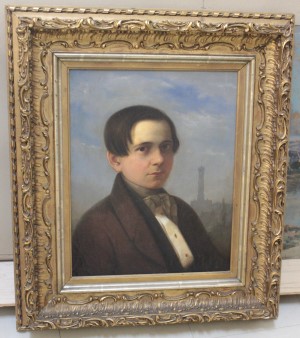
© Uemo German Culture Village Miyako-jima
In the book ‘Oberwesel, Pictures from the History of a small Town on a big River’ by Anton Ph. Schwarz, issued in 2004 by the Foundation for Culture Huette Oberwesel, you find an illustration, next to three others with works by Carl Haag, which depicts the arist as a youth. The reproduction of this image adorns the Carl Haag room in Oberwesel’s town museum. In this room you can also see Prince Charles’ letter written to the International Carl Haag Society on the occasion of its foundation in 2015. The 1844 self-portrait was supposedly kept in the town museum of Erlangen, but enquiries suggest that it is not known there.
However, investigations have found the self-portrait to have been in Japan for years, in fact it is in the Uemo German Culture Village in Miyako-jima on the island of Miyako, three hundred kilometres South of Okinawa. There is a museum which is an exact replica of the well known german ‘Marksburg’ castle from the middle Rhine area. Even the interior of the castle is very close to the original in Braubach. Just there three works by Carl Haag are exhibited, incl. the above mentioned early self-portrait.
The owner of a gallery was responsible for the small stock of pictures getting from Germany to Japan. They had been exhibited in 1983 in the short-lived ‘Museum of the Romaticism of the Rhine’ on the ‘Schoenburg’ castle in Oberwesel. They were part of the estate of Auguste (Gusti) Haag, the painter’s great-niece, who for many years lived as a violinist in St. Goar and died in 1982. Instructed by the executor an antiques dealer sold the picture together with six other items. The bill of sale describes it as follows: “self-portrait by the painter C. Haag, oil on canvas, 38/47.5 cm, painted 1844, no signature on the painted side, back signed by his own hand, heavy frame from the period.”
The portrait shows Carl Haag aged 24 years, looking younger and without a beard; it was painted shortly before or after his move from Nuremberg to Munich, where, having finished art college in Nuremberg, he quickly made a career of portrait painting and at the same time continued his own studies at the Munich Academy of Art.
The management of the Japanese Museum kindly photographed the pictures for us. There are: A watercolour from 1850 in a gilded frame showing the view to the Rhine from Oberwesel between the not yet extended Red Tower and the Ox Tower, and some steam ships, new at the time, (depicted in my book ‘Hofmaler Carl Haag’, Oberwesel 2003, available at the Kulturhaus Oberwesel); Carl Haag’s watercoloured drawings ‘The Red Tower with gateway and piece of the town wall. Its present condition. The Project of extension’, created in May 1864 (depicted in the above mentioned), and, in a magnificent gold frame of the 19th century, the self-portrait of the young Carl Haag from 1844.
We can see that for the photograph the picture was placed on the floor. In the background you can make out a tower, which town could it be?
© Walter Karbach 2015
Translated by Liz Hirst


